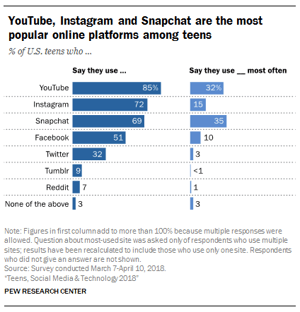Schools everywhere are struggling with this generation’s dependency on social media. In classrooms across the country, it is a constant battle to have students put their devices down and concentrate on their work. Instead of focusing on teacher instructions, assessments, and worksheets, students wonder who liked their latest post, how long their streak is, and what filter they should’ve used instead. Though it’s easy for educators to become frustrated with this “addiction”, maybe there is a way to harness it and shift student focus to the classroom.
According to Pew Research Center (article), 95% of teens have smartphones, and 45% say they’re online almost  constantly. Nine-in-ten teens admitted to going online multiple times per day. The biggest reason teens use social media: a connection with others. Through their interactions on these platforms, students receive validation, approval, and attention from their peers. In knowing that they are producing for an audience, they spend time perfecting content: using filters, rephrasing, cropping, and finding the ideal lighting. They are seeking approval,“likes”, and reaction from their audience. In some aspects, teens are attempting to influence what their peers think, believe, or do. They cultivate content for others, as a reflection of their own ideas, creativity, and self. When we look at this cultivation as educators, we see individuals who are conscientious, innovative, and eager to share the content they produce. What if that same attention was paid to what they create in the classroom? What if our students became these amazing content influencers, but for the learning happening in class?
constantly. Nine-in-ten teens admitted to going online multiple times per day. The biggest reason teens use social media: a connection with others. Through their interactions on these platforms, students receive validation, approval, and attention from their peers. In knowing that they are producing for an audience, they spend time perfecting content: using filters, rephrasing, cropping, and finding the ideal lighting. They are seeking approval,“likes”, and reaction from their audience. In some aspects, teens are attempting to influence what their peers think, believe, or do. They cultivate content for others, as a reflection of their own ideas, creativity, and self. When we look at this cultivation as educators, we see individuals who are conscientious, innovative, and eager to share the content they produce. What if that same attention was paid to what they create in the classroom? What if our students became these amazing content influencers, but for the learning happening in class?
In social media terms, an influencer is someone who has a significant impact on his or her audience. They set trends, and share content that persuades and sways people to “buy into” a brand. These people have become a crucial component in marketing, and have revamped the way businesses sell their products to the masses. The edited, filtered, cropped and hashtagged photo the influencer shares is delivered to thousands, sometimes millions, of followers who like, comment, and reshare the content in seconds. .png?width=300&name=Untitled%20design%20(7).png)
Now, let’s shift that same concept to the classroom, and make students the “influencers of learning.” As learning influencers, the brand they’re selling is the thinking they produce around the content, and their followers are their peers.
By utilizing this same desire for interconnectivity, teachers can engage students like never before. Imagine a classroom where students are excited to demonstrate their learning on platform teachers supplied for them. Now, instead of just filling in blanks, or trying to get the “right” answer in order to “get it done” for their teacher, students produce for their peers. Their thoughts, reactions, ideas, and “self” are shared on-screen for classmates to approve of and react to.
Because it is proven that teens crave interaction with others’ their age, and constantly seek their approval, apps like THiNKtech engage them in similar ways that social media platforms do.
Using functions like Speak iT allows students to create creative responses, cultivate content, and share it for others to listen to and learn from. Other tools like Sketch iT allow students to graphically demonstrate the knowledge they have, and the questions that stir up conversation. By utilizing THiNKtech in the classroom, educators give students access to a social media platform of learning, innovation, engagement, and intrigue.
In an article, “When Social Media Is Really Problematic for Adolescents,” (article) published by The New York Times, Dr. Radovic, an assistant professor of pediatrics at UPMC Children’s Hospital of Pittsburgh stated that “teens are really driven by their peers, really rewarded by peer interactions [...] They’re exploring their identity, being creative, and sharing things that they’ve done.” As educators, we need to seek out tools that will embrace this dependency in teens and use it to shift the learning in the classroom, instead of seeing social media as a battle never going to be won. The interconnectivity of THiNKtech’s functions allows students to produce, share, redesign, and create the content that their peers learn from, approve of, and react to. Now, instead of their focus being on filters, likes, and comments, they eagerly watch and listen to the buzz from their classmates as they press “share” to the screen, hoping that maybe they will influence others to learn along with them.


.png)
